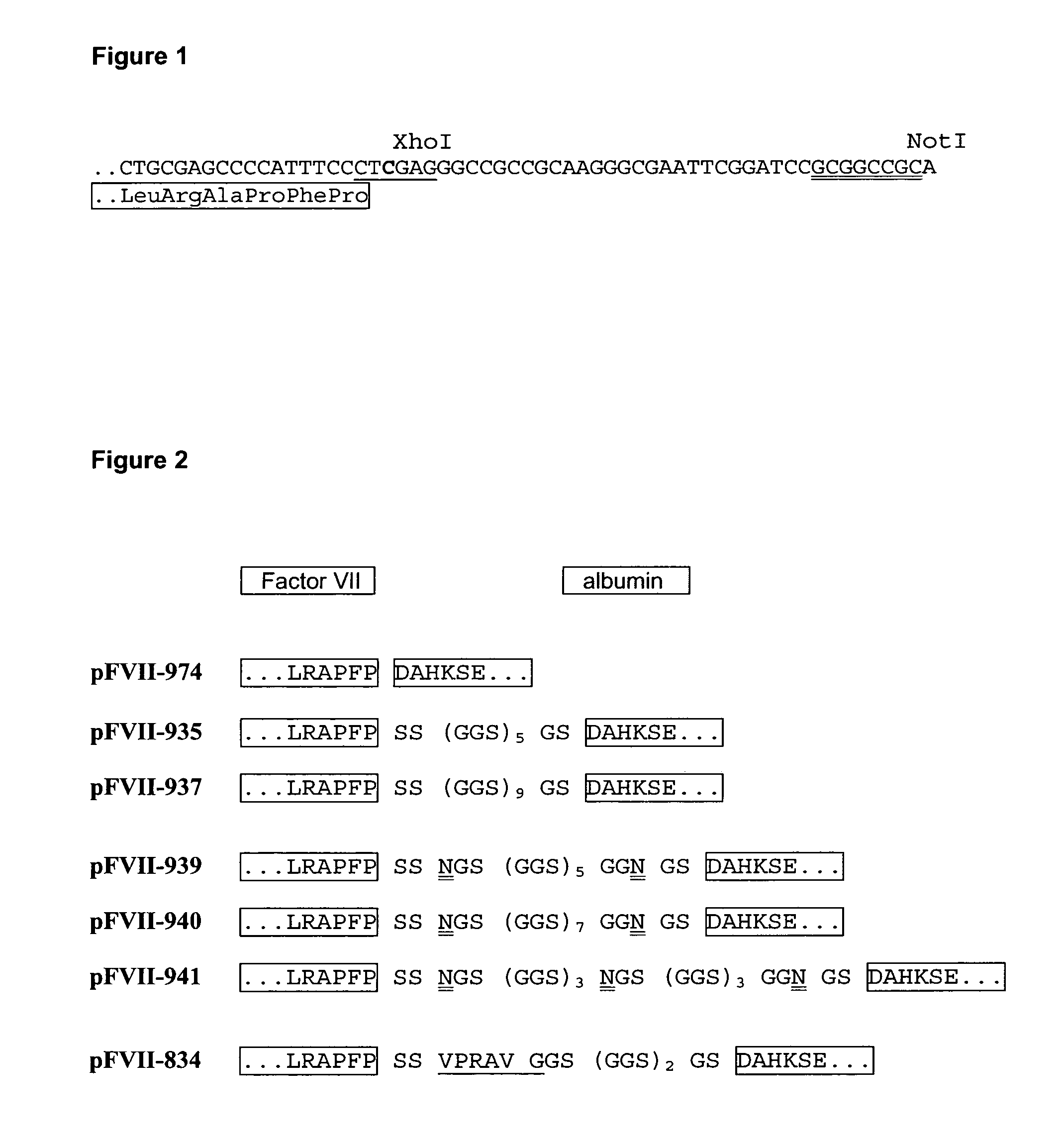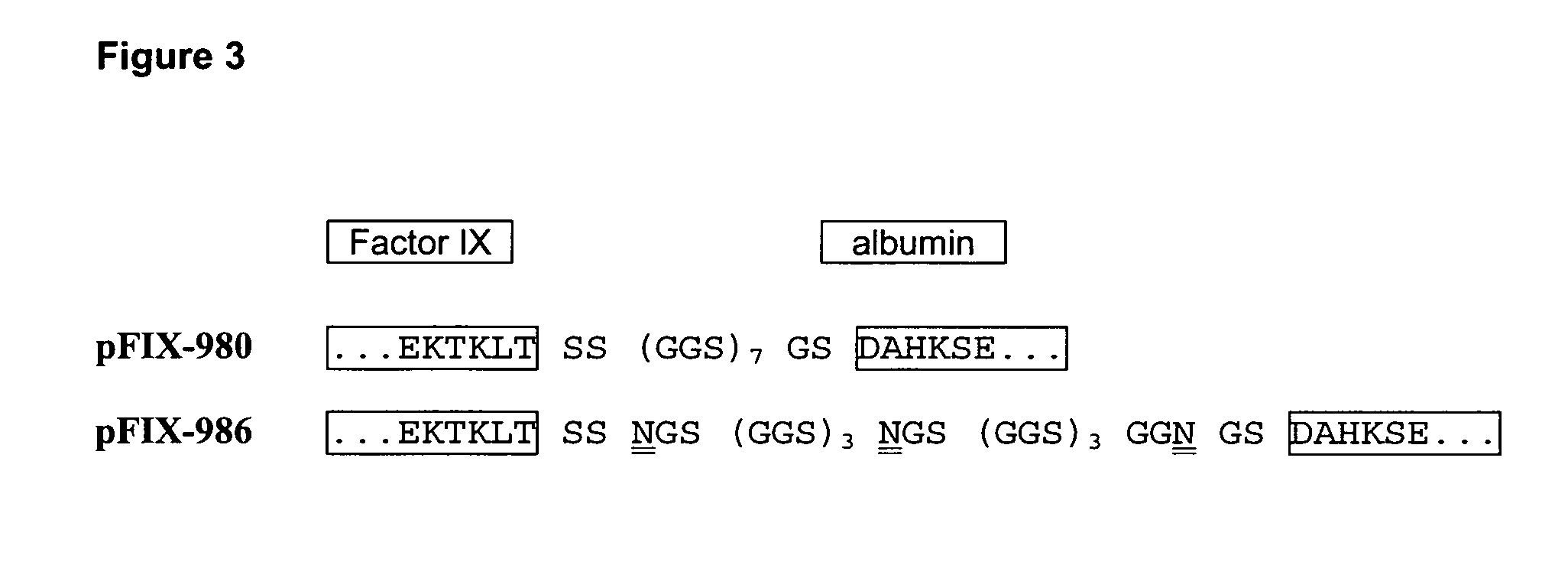Method of Increasing the In Vivo Recovery of Therapeutic Polypeptides
a technology of therapeutic polypeptides and in vivo recovery, which is applied in the field of modified therapeutic polypeptides, can solve the problems of limiting the application of in vivo recovery, reducing the in vivo recovery, and the half-life of factor viia of 2 hours, so as to improve and increase the in vivo recovery
- Summary
- Abstract
- Description
- Claims
- Application Information
AI Technical Summary
Benefits of technology
Problems solved by technology
Method used
Image
Examples
example 1
Generation of cDNAs Encoding FVII and FVII-Albumin Fusion Proteins
[0094]Factor VII coding sequence was amplified by PCR from a human liver cDNA library (ProQuest, Invitrogen) using primers We1303 and We1304 (SEQ ID NO 1 and 2). After a second round of PCR using primers We1286 and We1287 (SEQ ID NO 3 and 4) the resulting fragment was cloned into pCR4TOPO (Invitrogen). From there the FVI: cDNA was transferred as an EcoRI Fragment into the EcoRI site of pIRESpuro3 (BD Biosciences) wherein an internal XhoI site had been deleted previously. The resulting plasmid was designated pFVII-659.
[0095]Subsequently an XhoI restriction site was introduced into pFVII-659 at the site of the natural FVII stop codon (FIG. 1) by site directed mutagenesis according to standard protocols (QuickChange XL Site Directed Mutagenesis Kit, Stratagene) using oligonucleotides We1643 and We 1644 (SEQ ID NO 5 and 6). The resulting plasmid was designated pFVII-700.
[0096]Oligonucleotides We1731 and We1732 (SEQ ID NO ...
example 2
Generation of cDNAs Encoding FIX and FIX-Albumin Fusion Proteins
[0099]Factor IX coding sequence was amplified by PCR from a human liver cDNA library (ProQuest, Invitrogen) using primers We1403 and We1404 (SEQ ID NO 27 and 28). After a second round of PCR using primers We1405 and We1406 (SEQ ID NO 29 and 30) the resulting fragment was cloned into pCR4TOPO (Invitrogen). From there the FIX cDNA was transferred as an EcoRI Fragment into the EcoRI site of expression vector pIRESpuro3 (BD Biosciences) wherein an internal XhoI site had been deleted previously. The resulting plasmid was designated pFIX-496 and was the expression vector for factor IX wild-type.
[0100]For the generation of albumin fusion constructs the FIX cDNA was reamplified by PCR under standard conditions using primers We2610 and We2611 (SEQ ID NO 31 and 32) deleting the stop codon and introducing an XhoI site instead. The resulting FIX fragment was digested with restriction endonucleases EcoRI and XhoI and ligated into an...
example 3
Transfection and Expression of FVII, FIX and Respective Albumin Fusion Proteins
[0104]Plasmids were grown up in E. coli TOP10 (Invitrogen) and purified using standard protocols (Qiagen). HEK-293 cells were transfected using the Lipofectamine 2000 reagent (Invitrogen) and grown up in serum-free medium (Invitrogen 293 Express) in the presence of 50 ng / ml Vitamin K and 4 μg / ml Puromycin. Cotransfection of furinΔTM cDNA was performed in a 1:5 (pFu-797: respective pFIX construct) molar ratio. Transfected cell populations were spread through T-flasks into roller bottles or small scale fermenters from which supernatants were harvested for purification.
PUM
| Property | Measurement | Unit |
|---|---|---|
| Fraction | aaaaa | aaaaa |
| Therapeutic | aaaaa | aaaaa |
Abstract
Description
Claims
Application Information
 Login to View More
Login to View More - R&D
- Intellectual Property
- Life Sciences
- Materials
- Tech Scout
- Unparalleled Data Quality
- Higher Quality Content
- 60% Fewer Hallucinations
Browse by: Latest US Patents, China's latest patents, Technical Efficacy Thesaurus, Application Domain, Technology Topic, Popular Technical Reports.
© 2025 PatSnap. All rights reserved.Legal|Privacy policy|Modern Slavery Act Transparency Statement|Sitemap|About US| Contact US: help@patsnap.com


